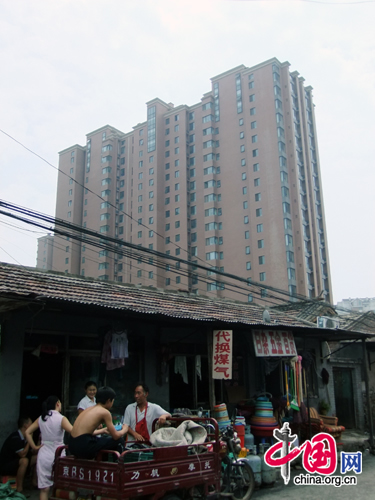Clash of eras in the Beijing suburbs
As Beijing marches relentlessly onwards and outwards like an advancing army, it is surrounding pockets of older villages that skirt the capital. The resulting contrast between old and new is the result of a few years of rapid development, but at first glance the gap could be a century or more.
 |
|
Zhongtan Village is adjacent to the Tiantongyuan high-rise development. [China.org.cn] |
The world of high-rise apartments, gated housing, Wal-Mart, B&Q and eight-lane highways sits a stone's throw from markets where chickens are sold live, feathered and clucking, not plucked and wrapped in polythene. Stall holders with swatters wage an unequal battle against flies feasting on displays of bean curd and pork. Toddlers play while their mums haggle over prices. There are no queues for the checkout here.
Zhongtan Village, to the north of Beijing, sits under the shadow of the Tiantongyuan high-rise development where apartments sell for around 13,000 yuan (US$1,900) per square meter. In the village, families typically rent for around 300 yuan per month.
The contrast in incomes and lifestyles has prompted city officials to devise new and controversial social control measures. Soon, it seems, the two worlds of Tiantongyuan and Zhongtan will be separated by a wall encircling the old village, complete with security cameras, iron gates and guards. To enter or leave between 11 pm and 6 am, residents will have to show a special pass.
In Daxing district, to the south of the city, a group of old-style villages have already been enclosed by walls under a so-called "community management" policy. And after the Beijing municipal Party secretary, Liu Qi, approved the scheme, it was decided to extend it to all villages around the city.
Xinhua reported Liu as saying the walls will improve village management, cut crime, improve the living environment and make residents feel safer.
The government may claim the policy is for the good of the villagers, but few Zhongtan residents seem to know much about it. A middle-aged couple selling home-made sesame jam in the street said they had never heard of it. A woman selling fruit in the market told us she remembered seeing guards at the edge of the village a while back but they had disappeared with no explanation being given.
And those villagers who knew about the proposed wall did not seem impressed.
"It will be like living in a prison," a taxi driver from a neighboring village where a wall is also planned, told us. He complained that he and his wife had been charged 10 yuan each for the new permits necessary to go in and out at night. "Everyone over one year old has to pay. And what happens when friends come to visit? Maybe it will make the place a bit safer, but there's no way they should charge for public services."
In fact it is not very clear whose safety the city officials have in mind – the people who will live inside the proposed village walls – or those in the new housing estates nearby. Most people who live in the villages are part of the so-called "floating population" of migrant workers. Places with a majority of migrants are tagged "upside-down villages." Zhongtan, where 30,000 "outsiders" outnumber locals by thirty to one, is one of the most "upside-down" in the Beijing area.
Zhongtan Village Party Secretary Zhang Liang says the area has a high crime rate. He claims crime dropped by 73 percent in Daxing after walls were built.
"The new policy will keep illegal motorcycles out and manage the floating population more effectively," Zhang said.
Certainly Zhongtan is no picturesque rural idyll. Motorcycles and motorized rickshaws buzz chaotically around streets strewn with garbage. Barber shops where old men cut hair sit next to others where young women offer what placards coyly describe as "adult health cures."
But talk of managing the floating population has raised objections from academics and netizens. Some believe the new walls are of a piece with a range of policies and institutions that discriminate against migrant workers.
Tang Jun, a researcher at the Chinese Academy of Social Sciences, rejects the idea that the floating population is the cause of high crime rates. "This sort of reasoning is nothing but a presumption of guilt. The "upside-down village" is an inevitable product of China's urbanization process. Actually, poor public security is the product of poor government, not large numbers of outsiders," Tang said.
Officials claim the new policy is non-discriminatory, but there are tell-tale slips of the tongue. Qu Guangshen, of the Dong Xiaokou County Information Office, explained "community management" to us with an example.
"If an outsider is seen carrying a bicycle on their shoulder, the guard can stop them to check them out. It will make the villagers' property much more secure," Qu said, before quickly correcting himself, substituting "anyone" for "outsider."
There certainly seems to be confusion about the new policy. One obvious question is – why bother to build walls around villages that, given the pace of development, may well be demolished within months?
According to the Beijing Daily, Zhongtan Village is due to be relocated along with five other villages at the end the year when, presumably, any walls and gates built by then would be abandoned.
"It's true that the two projects clash," Qu said. "But we'll find a way to accomplish both. It's an order from above anyway."
 0
0 







Go to Forum >>0 Comments